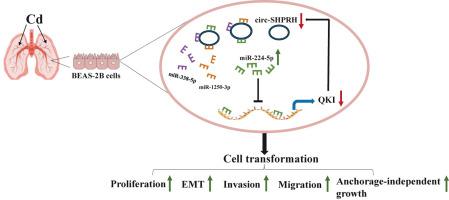Ecotoxicology and Environmental Safety ( IF 6.2 ) Pub Date : 2021-05-31 , DOI: 10.1016/j.ecoenv.2021.112378 Mei Zhou 1 , Luyao Li 1 , Biyun Chen 1 , Shuya Pan 1 , Wei Tu 1 , Yaxuan Hou 1 , Panpan Chen 1 , Rodolfo Rochín Hernández 1 , Xue Zhou 1

|
Circular RNAs (circRNAs) have been demonstrated to play critical roles in the pathogenesis of human cancers and carcinogenesis of several environmental pollutants. Nevertheless, the function of circRNAs in cadmium carcinogenesis is unclear. circ-SHPRH is down-regulated in many cancers including non-small cell lung cancer. In our present study, during cadmium-induced transformation of human bronchial epithelial BEAS-2B cells, epithelial-mesenchymal transition (EMT) was induced. Meanwhile, at the middle and late stages of cell transformation, cadmium down-regulated the expression of circ-SHPRH, as well as QKI, a tumor suppressor protein known to prevent the proliferation and EMT during progression of human cancers, compared with passage-matched control BEAS-2B cells. Overexpression of circ-SHPRH in cadmium-transformed BEAS-2B cells promoted the expression of QKI and significantly inhibited proliferation, EMT, invasion, migration and anchorage-independent growth in soft agar of the cells. Mechanistic studies showed that circ-SHPRH functioned as a sponge of miR-224–5p to regulate QKI expression. Interestingly, QKI and circ-SHPRH could form a positive-feedback loop that perpetuated circ-SHPRH/miR-224–5p/QKI axis. Collectively, our results demonstrated that circ-SHPRH inhibited cadmium-induced transformation of BEAS-2B cells through sponging miR-224–5p to regulate QKI expression under cadmium treatment. Our study uncovered a novel molecular mechanism involved in circRNAs in the development of lung cancer due to cadmium exposure.
中文翻译:

Circ-SHRPH通过miR-224-5p调节QKI表达抑制镉诱导的人支气管上皮细胞转化
环状RNA(circRNA)已被证明在人类癌症的发病机制和几种环境污染物的致癌作用中起着关键作用。然而,circRNAs在镉致癌作用中的作用尚不清楚。circ-SHHPH 在包括非小细胞肺癌在内的许多癌症中被下调。在我们目前的研究中,在镉诱导的人支气管上皮 BEAS-2B 细胞转化过程中,诱导了上皮间质转化 (EMT)。同时,在细胞转化的中后期,与传代匹配相比,镉下调 circ-SHRPH 以及 QKI 的表达,QKI 是一种已知可在人类癌症进展过程中阻止增殖和 EMT 的抑癌蛋白控制 BEAS-2B 细胞。在镉转化的 BEAS-2B 细胞中过表达 circ-SHRPH 促进了 QKI 的表达,并显着抑制了细胞在软琼脂中的增殖、EMT、侵袭、迁移和不依赖贴壁的生长。机理研究表明,circ-SHRPH 充当 miR-224-5p 的海绵来调节 QKI 表达。有趣的是,QKI 和 circ-SHHPH 可以形成一个正反馈回路,使 circ-SHPRH/miR-224-5p/QKI 轴永存。总的来说,我们的结果表明,circ-SHRPH 通过海绵 miR-224-5p 抑制镉诱导的 BEAS-2B 细胞转化,以调节镉处理下的 QKI 表达。我们的研究揭示了一种新的分子机制,涉及 circRNAs 在因镉暴露而导致的肺癌发展中。细胞在软琼脂中的迁移和不依赖锚定的生长。机理研究表明,circ-SHRPH 充当 miR-224-5p 的海绵来调节 QKI 表达。有趣的是,QKI 和 circ-SHHPH 可以形成一个正反馈回路,使 circ-SHPRH/miR-224-5p/QKI 轴永存。总的来说,我们的结果表明,circ-SHRPH 通过海绵 miR-224-5p 抑制镉诱导的 BEAS-2B 细胞转化,以调节镉处理下的 QKI 表达。我们的研究揭示了一种新的分子机制,涉及 circRNAs 在因镉暴露而导致的肺癌发展中。细胞在软琼脂中的迁移和不依赖锚定的生长。机理研究表明,circ-SHRPH 充当 miR-224-5p 的海绵来调节 QKI 表达。有趣的是,QKI 和 circ-SHHPH 可以形成一个正反馈回路,使 circ-SHPRH/miR-224-5p/QKI 轴永存。总的来说,我们的结果表明,circ-SHRPH 通过海绵 miR-224-5p 抑制镉诱导的 BEAS-2B 细胞转化,以调节镉处理下的 QKI 表达。我们的研究揭示了一种新的分子机制,涉及 circRNAs 在因镉暴露而导致的肺癌发展中。QKI 和 circ-SHRPH 可以形成一个正反馈循环,使 circ-SHRPH/miR-224-5p/QKI 轴永存。总的来说,我们的结果表明,circ-SHRPH 通过海绵 miR-224-5p 抑制镉诱导的 BEAS-2B 细胞转化,以调节镉处理下的 QKI 表达。我们的研究揭示了一种新的分子机制,涉及 circRNAs 在因镉暴露而导致的肺癌发展中。QKI 和 circ-SHRPH 可以形成一个正反馈循环,使 circ-SHRPH/miR-224-5p/QKI 轴永存。总的来说,我们的结果表明,circ-SHRPH 通过海绵 miR-224-5p 抑制镉诱导的 BEAS-2B 细胞转化,以调节镉处理下的 QKI 表达。我们的研究揭示了一种新的分子机制,涉及 circRNAs 在因镉暴露而导致的肺癌发展中。











































 京公网安备 11010802027423号
京公网安备 11010802027423号